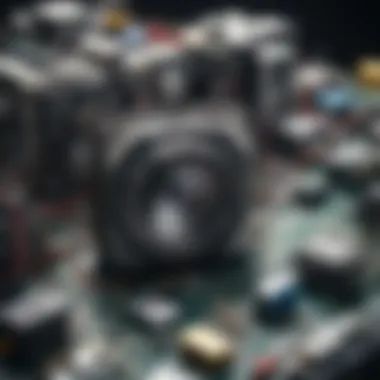Smart and Sustainable Computer Disposal Strategies


Overview of the Topic
Prelude to the Key Natural Resource or Environmental Issue
The disposal of computers has become an increasing concern in today's fast-paced world of technology. As new models and software continue to emerge, older computers often find their way into storage or, ultimately, waste. This waste poses serious environmental risks due to the potential contaminants and heavy metals (like lead, cadmium) that can leach into soil and water. Furthermore, improper disposal of computers translates into needless physical resources being wasted instead of recycled or repurposed.
Background Information on the Significance of the Topic
Understanding how to dispose of computers responsibly gears towards smarter environmental strategies. Not only does this issue involve ecological considerations, but it also intersects with data protection. In an age where personal data must be guarded, secure disposal practices are crucial. The electronic waste (e-waste) problem is multi-faceted; it engages various stakeholders—from individual users to corporations and waste disposal providers—making it pertinent in today's socio-economic landscapes.
Current Status and Challenges
Current State of the E-Waste Concern
Globally, the volume of e-waste generated remains an escalating crisis. The Global E-Waste Monitor estimated around 53.6 million metric tons of e-waste were produced in 2019. Only approximately 17% of this e-waste is recycled properly. The bulk of leftover equipment ends up in landfills or is incinerated, leading to hazardous consequences for both the environment and human health. Society has recognized the issue, but barriers to accomplishing effective recycling programs are abundant.
Challenges and Threats Facing Effective Disposal Practices
- Lack of Awareness: Many individuals and companies remain uninformed about proper e-waste disposal.
- Costs of Recycling: The expenses incurred for e-recycling and data wiping can deter smaller businesses.
- Regulatory Barriers: Changing laws regarding e-waste can present complications in compliance.
Considering these factors, casual approach can negatively affect sustainability.
Sustainable Solutions
Exploration of Sustainable Practices
Mitigating these concerns requires implementing sustainable practices. Responsible disposal calls for:
- Data Wiping Services: Companies like Blancco offer secure coding to protect information before disposal.
- Component Recycling: Materials recovered from computer hardware can lead to substantial savings in resource management.
Successful Case Studies
Countries like Sweden and Germany have showcased effective legislation promoting e-waste recycling. These nations bolster initiatives enhancing recycling rates through education and infrastructure investments, serving as substantial examples for policymakers worldwide.
Impact and Importance
Analysis of Topic's Importance to Different Stakeholders
The repercussions of improper computer disposal extend beyond immediate conception. Heavy metals infiltrate local ecosystems, adversely impacting flora and fauna. Communities can also feel the impact; From health risks due to toxic emissions linked to poorly managed disposal sites to lost economic opportunities associated with lost material recovery.—most notably in developing regions impacted via toxic waste trades.
Emphasis on Conservation
Promoting effective strategies in computer disposal should be ingrained in corporate responsibility and personal accountability. The future inherits the combined actions regarding environmental strategies today. Encouraging adaptation to innovative tech recycling, educating users, and strengthening legislation can foster conservation efforts.
Adopting rigorous disposal policies helps in mitigating risks contributing across web of environmental interactions, serving future generations with a healthier ecosystem.*
Understanding Computer Disposal
Understanding the process of computer disposal is paramount in today's technology-driven society. Every year, millions of computers reach their end of life. Handling this waste requires a nuanced understanding of responsible disposal methods, which have significant implications for our environment and society. Approaching computer disposal with diligence helps combat potential hazards associated with electronic waste.
Importance of Responsible Disposal
Responsible disposal cannot be overstated. Improper disposal of computer equipment can lead to the release of toxic substances into our environment. For instance, heavy metals like lead and mercury can contaminate soil and water if devices are discarded in landfills.
Choosing more sustainable options not only mitigates environmental risks but also promotes the ethical handling of resources. Moreover, such practices can generate economic opportunities, such as job creation in recycling, refurbishing, and upcycling sectors. Thus, responsible disposal forms a critical part of our collective ethos towards a more eco-friendly future.
Environmental Impact of E-Waste
Electronic waste, commonly known as e-waste, poses noteworthy environmental challenges. It is categorized as one of the fastest-growing waste streams globally, primarily due to the rapid obsolescence of technology and the increasing demand for new gadgets.


When computers and other electronics are improperly disposed of, hazardous materials enter the landfill ecosystem. This has detrimental effects including:
- Soil contamination: Chemicals leach into the ground, impacting land fertility.
- Water pollution: Toxins can seep into groundwater, which may end up in drinking water supplies.
- Air quality: Burning e-waste releases harmful pollutants into the air.
Furthermore, the inefficiencies in recovering valuable materials from disposed electronics accentuate the importance of effective recycling initiatives. Resources such as copper, gold, and aluminum can be extracted, reused, and redistributed back into the manufacturing cycle, sparing the environment from additional strain.
A report by the United Nations suggests that only about 20% of global e-waste is recycled properly, underscoring the urgency of raising awareness and improving disposal practices.
Taking our environmental impact seriously and adopting strategic approaches towards computer disposal will contribute enormously to reducing adverse ecological effects. Engaging both individuals and organizations alike will be a giant step forward in reducing our collective footprint.
Preparing Your Computer for Disposal
Preparing your computer for disposal is a critical step in the process that ensures data security and environmental responsibility. It sets the foundation for a responsible disposal process, which brings peace of mind knowing that personal information is protected and electronic waste is managed properly. This phase requires careful consideration of several factors, including how to back up essential data and effectively remove sensitive information from the device. With technology continuously evolving, knowing the appropriate preparation steps can help prolong the life of existing hardware or ensure a seamless transition to alternative solutions.
Data Back-Up Procedures
Before disposing of a computer, one must back up important data. This ensures that essential files, such as documents, images, and other personal content, are not lost forever. Various methods may be employed for data backup, depending on user needs and preferences. Common choices include external hard drives, cloud storage services like Google Drive or Dropbox, and saving files directly to a USB flash drive. By using both physical and cloud options, the user improves the likelihood of having access to their data even if the device fails prior to disposal.
Key tips for data backing up include:
- Evaluate what data is vital.
- Choose a reliable backup method.
- Perform periodic backups to keep files current.
These strategies can protect vital information against unexpected incidents or procedural missteps during the disposal phase.
Secure Data Wiping Techniques
Once data is backed up, secure data wiping is essential to ensure that none of the sensitive information can be accessed by unauthorized individuals after disposal. Secure data wiping techniques effectively erase data from storage devices, rendering it unrecoverable and preserving personal privacy. There are two main approaches: using software utilities designed for data deletion and physically destroying storage drives. Choosing the right option depends on multiple factors including the type of data, time constraints, and resources available.
Software Options for Data Wiping
Software options for data wiping provide users with a method for effectively and securely erasing information from devices. These programs can perform multiple overwrites, implementing algorithms that eliminate all existing data and ensure that it cannot be retrieved by forensic recovery techniques. Many software tools offer features such as document-by-document erasure or full disk wipes, depending on user needs.
Two features why software options are favorable include:
- Cost-effectiveness: Most software options are free or low-cost.
- Efficiency: Many tools function quickly, enabling users to dispose of their computers faster than traditional methods.
That said, software options may come with limitations. They often require time to effectively complete the process, which may not suit every user's needs.
Physical Destruction of Drives
Physical destruction of drives is the most secure way to mitigate risks associated with sensitive information. This process involves shredding, crushing, or puncturing storage devices, which ensures that the data is irrevocably destroyed. Unlike hacking risks associated with software data wiping, physical destruction completely eliminates the potential for data recovery.
Advantages of physical destruction include:
- 100% Data Security: Once destroyed, recovery is impossible.
- Immediate Verification: Users can physically inspect the damage, phsyically confirming safety.
Empire disadvantages to note is this method can be costlier and less environmentally friendly. Some methods may contribute to e-waste if the destroyed components are not properly handled afterward. Although the safety it provides must be weighed against practical considerations in a responsible disposal plan.
Remember that adequate preparation prior to disposal — including backing up data and securely wiping it — is essential to safeguard information and reduce environmental impact.
Recycling Options for Computers
Recycling options for computers are crucial in the ecosystem of responsible e-waste management. Computers contain valuable materials that can be reused, and recycling prevents them from ending up in landfills where they may cause environmental harm. Utilizing recycling options promotes conservation of resources and minimizes negative impact on the earth. By focusing on how and where to recycle computers, individuals and organizations can contribute significantly to sustaining ecosystems and managing e-waste ethically.
Local Recycling Programs
Local recycling programs are pivotal in ensuring that computers are disposed of in an environmentally friendly way. Many municipalities have established designated recycling facilities where citizens can drop off their old electronics for responsible processing. This not only simplifies the recycling process for consumers but also ensures materials are handled correctly. Local programs might offer specific collection events or permanent drop-off sites.


Benefits of participating in local recycling programs include:
- Easy access to recycling resources in your community.
- Assurance that the recycling is done in accordance with legal regulations.
- Potential to earn incentives, like tax deductions or discounts on future purchases.
It is essential for consumers to be aware of what materials are accepted, as accepted items can vary by location. Many programs accept monitors, laptops, and printers, among other types of e-waste. However, some may have restrictions on items due to local laws or equipment capability constraints.
Manufacturer Take-Back Programs
Manufacturer take-back programs create a direct path for recycling. These programs require consumers to return their old devices to the producing companies to recycle the components safely and professionally. Many leading technology companies, such as Apple and Dell, offer this service.
Participation in these programs enhances the recycling process through:
- Ensured data security because devices are often wiped clean before refurbishment or recycling.
- Reduced waste since manufacturers can repurpose or recycle their own old models.
- Promotion of corporate responsibility as manufacturers take ownership of their produced items even after the sale.
Contacting the manufacturer can help clarify policies on the program, such as shipping details, costs, and potential trade-in values for old models.
Electronics Recycling Events
Electronics recycling events provide a unique opportunity for communities to contribute to e-waste recycling in a central location. These events are usually organized by local governments or environmental organizations and promote awareness about recycling. Events vary in frequency, from quarterly to annual occurrences, with numerous drop-off days that families can utilize.
Benefits of attending these events include:
- Free disposal of electronics in a safe environment.
- Community engagement with the shared goal of reducing e-waste.
- Access to educational sessions on electronic waste management.
Pairing events with educational campaigns enhances community engagement. Knowing where to find such events or scheduling one yourself can foster stronger local practices regarding sustainable disposal. To maximize participation, promotional strategies via social media or local newsletters could be very efficient.
In summary, employing recycling options, such as local programs, manufacturer take-back initiatives, and community events, ensures a sustainable approach to managing old computers, while straightening the duty of all stakeholders towards environmental conservation.
Donation and Reuse Options
Donating and reusing old computers is an essential strategy in promoting a sustainable environment. It plays a vital role in reducing electronic waste and extending the lifecycle of technological devices. This process not only benefits the environment but also helps those in need, making it a socially responsible practice. Tools that may seem obsolete can still provide value to individuals or organizations if put to good use.
The contributions of computer donations are numerous. First, they help bridge the digital divide by providing necessary tools for students, low-income families, and non-profits who may lack resources. Second, by donating instead of discarding, valuable materials in the hardware remain utilized instead of heading to landfills. This diminishes the demand for new devices, ultimately reducing the harmful environmental impact of manufacturing processes and the resource depletion associated with them.
When considering donating your computer, it's essential to assess its suitability for donation to ensure it is genuinely helping recipients. Hence, understanding criteria for donating is critical.
Criteria for Donating Computers
Evaluating if a computer is fit for donation requires attention to several key factors:
- Functionality: Ensure the computer operates properly without significant issues. A fully functioning machine is more likely to be useful.
- Age: Many organizations accept computers that are not older than five years. Technology advances rapidly, so more recent models are often preferred.
- Condition: The physical condition should reflect no major damage. Check that components like the screen, keyboard, and chassis are intact and in working condition.
- Up-to-Date Software: Computers equipped with current operating system versions and necessary software make them more appealing for donation.
- Data Security: Execute data wiping and data protection protocols to safeguard sensitive information before donation.
Considering these criteria enhances the likelihood that the donation will have positive outcomes for people and the environment.
Charitable Organizations Accepting Donations
Several charitable organizations actively accept donations of used computers. Engaging with them can ensure that your contributions make a substantial impact. Here is a list of notable organizations:
- Computers with Causes: Focuses on connecting generous donors with charities and individuals in need, distributing tangible benefits in the form of computers.
- Goodwill Industries: Accepts computers and other electronic devices, often providing job training for individuals working in donation centers.
- TechSoup: Partners with NGOs to supply technology resources, often heavily subsidizing costs to make devices accessible in the nonprofit sector.
- The National Cristina Foundation: Facilitates computer donations aimed at supporting people with disabilities and other disadvantaged demographics.
The role of donating computers extends beyond tangible donations. By choosing the path of reuse, we engage in environmental stewardship while providing essential resources to underserved communities.
“Every donated computer has the potential to change a life or empower an organization.”
This responsibility falls on each of us as members of a digitizing world, ensuring that technology fulfills its promise of progress and inclusivity.
Legal Considerations for Computer Disposal


Understanding E-Waste Regulations
As the proliferation of electronic devices continues to rise, so too does the significance of e-waste regulations. Each country may have distinct laws governing the disposal of old computers, dictated by the need to protect the environment and public health. These regulations outline how electronic waste should be managed throughout its lifecycle. Numerous international treaties, like the Basel Convention, focus on controlling the transboundary movement of hazardous waste and establishing criteria for the responsible processing of e-waste.
In the United States, various states have implemented laws addressing e-waste disposal and recycling. Each state must ensure compliance with federal laws, such as the Resource Conservation and Recovery Act (RCRA). Understanding these regulations is essential as they mandate best practices for handling electronics, often including disposal guidelines, collection programs, and penalties for non-compliance. While researching these regulations may seem daunting, adhering to them can avoid potential fines and promote a culture of environmental responsibility among individuals and organizations.
Regulations regarding electronic waste disposal reflect a growing recognition of its complex environmental impacts.
Consequences of Improper Disposal
Failing to properly dispose of computers can have serious ramifications for both the environment and individuals. Improper disposal can lead to the release harmful substances like lead, mercury, and cadmium into soil and water systems. These heavy metals contribute to soil degradation and can contaminate drinking water sources, posing health risks for communities. This poses a threat to aquatic and terrestrial ecosystems, endangering wildlife and disrupting food chains.
Moreover, individuals or organizations may face legal consequences from improper disposal, in terms of both civil and criminal charges. There are fines that may result from noncompliance with local and federal regulations relating to e-waste. For businesses, such consequences may extend to reputational damage, as consumers favor companies with responsible disposal and sustainability practices.
In summary, proper disposal of computers is not only a legal obligation but an ethical one. Systematic restructuring of disposal practices and adherence to regulations can promote both ecologically sound and socially responsible actions in the face of marital challenges posed by e-waste.
Alternatives to Disposal
Exploring alternatives to traditional disposal methods is crucial in our quest for responsible management of electronic waste. Often, computers may seem unusable or obsolete, but they possess various components and functions that can be repurposed or upgraded. Embracing these alternatives not only prolongs the useful life of technological devices, it also lessens the impact on the environment by reducing waste and energy consumption.
Upgrading vs.
Disposing
When considering the future of an old computer, the choice between upgrading or disposing of it can be significant. Upgrading components like RAM, storage drives, or even graphics cards can transform an aging system into an efficient machine. This process often costs less than purchasing a brand-new computer. Additionally, such an approach minimizes e-waste which contributes to the growing concern of electronic pollution.
The benefits of upgrading include:
- Cost Effectiveness: Often, patching existing systems is more economical than investing in new technology.
- Skill Development: The upgrade process can enhance knowledge of hardware and software, equipping individuals with skills that might prove valuable.
- Reduced E-Waste: Keeping computers functional means less component waste heading to landfills.
When striving for sustainability, it’s essential to evaluate whether an older computer can be efficiently upgraded. Checking the relevance of parts is key. If budget permits and extra time can be spared, junking the old may be the last option.
Repurposing Old Computers
Repurposing old computers serves as another eco-friendly strategy for dealing with outdated technology. This involves creatively adapting computers to fulfill new functions, hence extending their lifecycle.
Some considerations for repurposing include:
- Using as a Media Center: Older machines can be transformed into home entertainment systems, streaming media content.
- Creating a Home Server: They can function as a server for file storage, providing secure access to files around the home network.
- Replacing Toolbox: Old devices can be good candidates for running lightweight applications, acting as additional machinery for remote teams or specialized projects.
Repurposing also has educational value. Younger generations can learn about technology by modifying and experimenting with old systems rather than using brand-new ones, which sometimes carry compositional barriers that make exploring technology more intimidating.
Best Practices for Sustainable Disposal
Responsible actions regarding computer disposal play a vital role in reducing environmental impact and promoting sustainability. By following best practices, individuals and organizations can significantly contribute to easing e-waste burdens. Sustainable disposal is necessary not only to protect our planet but also to safeguard sensitive data and comply with applicable laws.
Adhering to best practices enables recyclers to extract valuable resources from old devices, potentially providing raw materials for new products. Involving in maintaining the cycle of resource use and supporting recycling facilities also offers social benefits to are involved parts of ecosystem.
Checklist for Disposal
A proper checklist helps ensure the systematic and thorough disposal of computers. Keeping track of each step in the disposal process helps minimize risks and contribute to environmental health.
- Assess the Condition: Evaluate if the computer is fit for donation, recycling, or raw parts.
- Backup Important Data: Ensure some data is saved before permanence of disposal.
- Wipe Data Securely: Use reliable methods to remove sensitive information thoroughly.
- Separate Components: Organize parts, e.g., monitors, hard drives, which often have different recycling processes.
- Select a Responsible Recycler: Choose certified e-waste recyclers familiar with relevant regulations.
- Stay Informed: Check local e-waste laws and be compliant
This checklist ensures the disposal process is reliable and thorough, helping the environment and aiding community efforts.
Educating Others on E-Waste
Awareness about e-waste is crucial. Education against the new public will secure the future environments. Spreading knowledge can lead to cautious behaviors concerning electronic devices and their life cycles as well.
- Seminars and Talks: Organizing events inform surrounding about adverse impacts of e-waste and advantages of proper disposal.
- Social Media Campaigns: Utilize channels on platforms like Facebook and Reddit to engage the community.
- Community Workshops: Running related hands-on activities promotes skills in recycling or constructing.
By fostering awareness and communicating benefits or consequences, extensive changes may arise around how others approach disposal. Adopt a proactive viewpoint towards correctly handling e-waste and ensure community stays educated and responsibly involved.
"Responsible computer disposal is not just a personal choice; it is a societal obligation that we all must acknowledge."



